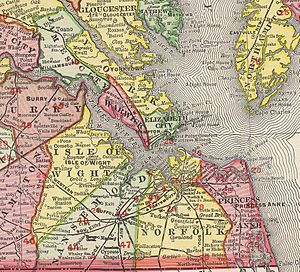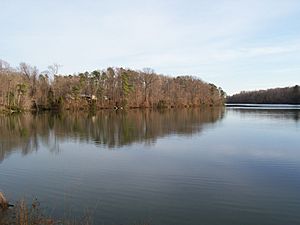Warwick County, Virginia facts for kids
Warwick County was an important area in Southeast Virginia. It began as Warwick River Shire, one of eight original areas set up in the Virginia Colony in 1634. Over time, it grew and changed. On July 16, 1952, it officially became the City of Warwick.
This area is located on the Virginia Peninsula, along the northern side of the James River. It sits between Hampton Roads and Jamestown. For many years, Warwick County was mostly made up of farms and small villages.
Things began to change in 1881. This is when the Chesapeake and Ohio Railway (C&O) built its Peninsula Extension into the area. A powerful businessman named Collis P. Huntington led much of this growth.
The new railroad brought many changes. It led to the building of coal piers, where coal was loaded onto ships. There were also several train stations in Warwick County. These stations helped people travel and allowed farmers to ship their crops and seafood to markets. The railroad also connected to nearby resorts and military bases in Elizabeth City County.
The community at the southeastern edge of Warwick County, near the harbor of Hampton Roads, grew quickly. This area became the city of Newport News in 1896. It soon became home to the world's largest shipyard, where many ships were built.
During World War I, the U.S. Army built a military base in Warwick County. This base later became Fort Eustis. After the war, another former military site, Camp Patrick Henry, became the location for the Newport News/Williamsburg International Airport.
For many years, Warwick County and Newport News discussed how their local governments could work together. Finally, after more than 325 years as a separate county, the City of Warwick joined with the younger city of Newport News. This happened on July 1, 1958. The combined area took the more famous name of "Newport News." Today, it is one of the major cities in the Hampton Roads region.
Contents
Early Colonial Life in Warwick County
In the 1600s, soon after the first English settlement at Jamestown in 1607, settlers began exploring and living in the areas around Hampton Roads. By 1634, the English colony of Virginia had eight main areas. These were called shires or counties. About 5,000 people lived in the colony at that time.
Warwick River Shire was named after Robert Rich. He was the second Earl of Warwick and an important member of the Virginia Company. He also owned a large farm called Richneck Plantation. Warwick River Shire officially became Warwick County in 1643.
The first courthouse and jail for Warwick County were built in a place called Warwick Towne. This town was started in 1680. The main port for the colony in this area was located at Deep Creek and the Warwick River. It was built on about 50 acres (20 hectares) of land owned by Samuel Mathews.
From as early as 1635, Warwick River County included several Anglican Parishes. These were smaller local areas for government, religious activities, and community life. Some of these parishes included Blount Point, Denbigh, Mulberry Island, and Warwick.
Warwick County During the American Revolution
Warwick County became very important for building ships during the American Revolutionary War. The Virginia General Assembly, which was the state's lawmaking body, started buying land to build naval ships.
Virginia owned more land, buildings, and factories for naval purposes than any other state. Sampson Mathews helped manage the shipbuilding operations in Warwick. This made Warwick the most important shipbuilding center in Virginia during the war.
After the war, in 1786, the General Assembly passed the Virginia Statute for Religious Freedom. This law ended the official status of the Church of England in Virginia. This also meant that the original colonial parishes within Warwick County were no longer official government units.
Virginia Statehood and the 1800s
In 1790, the first official count of people in the United States showed that Warwick County had 1,690 residents. This made it one of the smallest counties in Virginia at the time.
In 1809, Warwick Towne was no longer used as the county seat. The county government moved to the area of Denbigh, near Stoney Run.
In Denbigh, Warwick's first brick courthouse was built in 1810. This building also served as the clerk's office and a jail. Later, in 1884, a larger courthouse was built on the same land. The old building was still used by the clerk. Both buildings served the county until it joined with Newport News in 1958.
The Railroad Arrives and a New City Grows
After the American Civil War ended in 1865, land agents started buying land in Warwick County. They were working for Collis P. Huntington, a very rich railroad owner. He planned to build a new city at the southern end of the county.
In 1880, Huntington created the Old Dominion Land Company. He gave all his land in Warwick County to this company. The next year, in 1881, it was announced that Newport News would be the new deep-water port for the Chesapeake and Ohio Railway (C&O).
Construction on the C&O's Peninsula Extension began at Newport News Point in December 1880. Another team started building the railroad east from Richmond in February 1881. They met near Williamsburg on October 16, 1881.
The C&O railroad helped transport people to the Yorktown Centennial celebration on October 19. Over the next few years, Huntington developed the southeastern part of Warwick County a lot. He even built a new Hotel Warwick. In 1886, Huntington also started the Newport News Shipbuilding and Drydock Company.
The fast-growing community of Newport News became an independent city in 1896. This was made possible by a law passed by the Virginia General Assembly. Newport News was one of the few cities in Virginia that was never officially a "town" first. At one point, it became Virginia's third-largest city by population.
Military Bases in the 20th Century
In 1918, Warwick County became the home of a new military base called Camp Abraham Eustis. This base was later renamed Fort Eustis. The U.S. Army built this base quickly during World War I near the mouth of the Warwick River. It included Mulberry Island.
Lee Hall, Virginia was the closest train station to the base. It handled a lot of troop movement, especially during World War II. This was when another base, Camp Patrick Henry, was built nearby.
Camp Patrick Henry was mainly used to prepare troops for deployment during World War II. It was part of the Hampton Roads Port of Embarkation. The camp was started in late 1942 and covered about 1,700 acres (6.9 square kilometers) of mostly untouched forest. At its busiest, Camp Patrick Henry could hold about 35,000 soldiers. After World War II, the camp closed. The land was then used to build a commercial airport, which is now known as Newport News/Williamsburg International Airport.
Historical Population Data
| Historical population | |||
|---|---|---|---|
| Census | Pop. | %± | |
| 1790 | 1,690 | — | |
| 1800 | 1,659 | −1.8% | |
| 1810 | 1,835 | 10.6% | |
| 1820 | 1,508 | −17.8% | |
| 1830 | 1,570 | 4.1% | |
| 1840 | 1,456 | −7.3% | |
| 1850 | 1,516 | 4.1% | |
| 1860 | 1,740 | 14.8% | |
| 1870 | 1,672 | −3.9% | |
| 1880 | 2,258 | 35.0% | |
| 1890 | 6,650 | 194.5% | |
| 1900 | 4,888 | −26.5% | |
| 1910 | 6,041 | 23.6% | |
| 1920 | 11,417 | 89.0% | |
| 1930 | 8,829 | −22.7% | |
| 1940 | 9,248 | 4.7% | |
| 1950 | 39,875 | 331.2% | |
| 1790-1950 Population as Warwick County | |||



